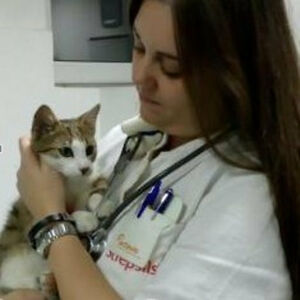The warmth radiating from your cat’s ears can be a subtle yet significant indicator of their well-being. This comprehensive guide aims to unravel the mysteries behind hot ears in cats, focusing mainly on the link between elevated ear temperature, ear infections, and overall pet health.
Cats are notorious for masking signs of discomfort, making it crucial for pet owners to interpret subtle cues. As we delve into the reasons behind hot ears, ranging from natural responses to environmental factors to potential health issues, we embark on a journey to empower pet owners with the knowledge needed for vigilant care.
- Hot cat ears may indicate fever, infection, or stress.
- Ear infections can escalate if untreated, impairing hearing.
- Regular ear cleaning prevents debris and infections.
- Cats' fever signs include lethargy and warm ears.
- Stress can cause warm ears in cats due to increased blood flow.
Understanding the nuances of ear infections, detecting fever, and unraveling the impact of stress on feline physiology are essential components of this guide.
The information provided herein is for informational purposes only. Please refer to our disclaimer for more details..
Why are my cat’s ears hot?
- Warm ears in your cat may originate from various factors, with heightened blood flow being just one aspect. Environmental influences, such as a warm climate or exposure to direct sunlight, can naturally cause an increase in ear temperature.
- Physical exertion and excitement during playtime may also contribute to temporary warmth. However, persistent heat in the ears might signal underlying health issues like infections, inflammation, or even fever. Ear mites, a common feline issue, can provoke irritation, leading to warmer ears.
- Additionally, stress or anxiety can trigger physiological responses, potentially manifesting as elevated ear temperature. Considering these diverse causes underscores the importance of observing your cat’s overall behavior and health, ensuring a holistic approach to their well-being.
- Regular monitoring becomes indispensable, enabling pet owners to discern between innocuous warmth and indicators of potential health concerns.
Understanding Ear Infections
Ear infections in cats present a spectrum of complexities, with bacterial, fungal, and parasitic origins contributing to diverse manifestations. Bacterial infections often result from an overgrowth of naturally occurring bacteria in the ear canal, causing inflammation.
Image credits: Erik-Jan Leusink
Symptoms that a cat has an ear infection include redness, swelling, and discharge, accompanied by the telltale warmth in the ears.
Fungal infections, such as yeast infections, thrive in warm, moist environments and can provoke similar symptoms. Parasitic infections, commonly caused by ear mites, lead to intense itching, redness, and inflammation. In all cases, the key is early detection and intervention.
Untreated infections may escalate, causing discomfort, hearing impairment, and, in severe instances, spreading to other parts of the body, posing a threat to overall feline health. Regular checkups at veterinary clinics and prompt treatment are essential in managing and preventing the complications associated with these diverse ear infections.
Prevention and Home Care
Preventing ear infections in your cat requires a proactive approach encompassing various measures. Regular cleaning using veterinarian-approved solutions is a cornerstone in maintaining ear hygiene.
This practice aids in preventing the accumulation of debris, a common precursor to infections. You create an additional layer of defense against potential contaminants by upholding a hygienic living environment. Ensuring a balanced diet is crucial, as proper nutrition bolsters your cat’s immune system, fortifying their ability to fend off infections.
Regular grooming, including attention to ears, is equally vital, as it aids in maintaining overall cleanliness and health. These collective efforts significantly minimize the likelihood of cat ear infections, providing a comprehensive strategy for promoting your kitty companion’s well-being and preventing potential health issues.
How do you tell if a cat has a fever?
Ensuring your cat’s well-being involves vigilant monitoring, especially when it comes to detecting a fever. A cat’s natural body temperature is 100.5 to 102.5 degrees Fahrenheit (38 to 39.2 degrees Celsius). To accurately measure this, employ a digital thermometer specifically designed for pets, with the rectal method being the most reliable.
Image credits: Gustavo Fring
Signs indicating a potential fever in cats extend beyond just the numerical measurement. Watch for behavioral changes, such as lethargy and loss of appetite, which are common indicators.
Additionally, shivering and, interestingly, when cat ears and paws feel warm to the touch can suggest a heightened body temperature. If these signs manifest, seeking prompt vet advice ensures a thorough diagnosis and appropriate treatment, safeguarding your cat’s health and well-being.
Do cat’s ears get warm when they are stressed?
Indeed, a cat’s ears can exhibit warmth as a response to stress, reflecting the intricate connection between their emotional state and physiological changes. Stress triggers various bodily responses, notably increased heart rate and blood flow.
This heightened circulation can lead to warmer ears, serving as a visible sign of the cat’s emotional distress. However, it’s crucial to note that while stress is plausible, persistent warmth in the ears may signify an underlying condition.
Monitoring your cat’s behavior and additional symptoms is imperative to discern between stress-related warmth and potential health issues. If uncertainty persists, seeking advice from your vet becomes paramount, ensuring a comprehensive evaluation and appropriate care to safeguard your cat’s overall well-being.
When to Consult a Veterinarian
Recognizing the significance of seeking professional advice for your cat’s well-being is paramount in ensuring their optimal health. Incorporating regular veterinary check-ups into your feline companion’s healthcare routine establishes a proactive approach to preventive care.
Persistent warmth in the ears serves as a notable indicator, and when coupled with signs of discomfort or observable behavioral changes, it becomes crucial to promptly consult your veterinarian.
Early detection of potential health issues facilitates timely intervention, a pivotal factor in addressing concerns effectively. This proactive stance contributes to resolving current health issues and is pivotal in maintaining your cat’s long-term health and fostering a life characterized by vitality and happiness.
By staying attuned to your cat’s well-being and partnering with a veterinary professional, you create a foundation for a healthy, fulfilling life for your cherished feline companion.
Remember, each cat is unique, and understanding your individual cat’s needs, habits, and health history is key to providing the best possible care.
Here are some additional points to consider regarding the topic of hot ears in cats, ear infections, and pet health:
- Breed Predispositions: Certain cat breeds may be more prone to ear-related issues. For example, cats with long ears, like the Persian breed, may be more susceptible to ear infections due to reduced air circulation.
- Allergies: Cats can develop allergies to various substances, and this can manifest as ear inflammation or infections. Identifying and addressing potential allergens can aid in preventing recurring ear problems.
- Age-Related Considerations: Kittens and senior cats may have different vulnerabilities regarding ear health. Adapting preventive measures based on age can contribute to tailored care.
Hot ears in cats should never be dismissed, as they hold crucial insights into the overall health of your feline companion. Responsible pet ownership necessitates a profound understanding of the potential causes behind ear warmth. This involves being attuned to subtle shifts in your cat’s behavior and appearance, acknowledging these as potential indicators of underlying issues.
Proactive measures become imperative, encompassing regular check-ups, preventative care routines, and swift veterinary attention when needed. Regular veterinary check-ups serve as proactive health measures, enabling the early detection of any emerging concerns. You can minimize the risk of ear-related issues through preventive care, including proper hygiene practices and a balanced diet.
Swift veterinary attention ensures that any concerns are addressed promptly, preventing the escalation of potential health issues. By prioritizing your cat’s health, you actively contribute to a companionship characterized by happiness, vitality, and a thriving, lasting bond with your feline friend.
176views
Share on Facebook
 Dark Mode
Dark Mode 

 No fees, cancel anytime
No fees, cancel anytime 




















































-1
0